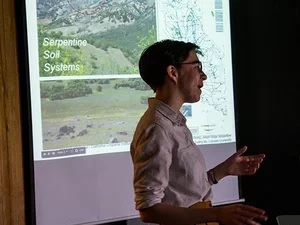Community Assembly in Patchy Environments
A Simulation Model of Plants in a Heterogeneous World
Thesis by Mieke Vrijmoet '16

Abstract: Model systems allow ecologists to test and demonstrate many generalized ecological principles. Archipelagos, elevation gradients, and abandoned fields are among the systems ecologists have recruited to establish analytical relationships of effects between factors observable in many systems but often obscured by co-occuring effects. Serpentine soils, which are a relatively harsh soils typically found embedded in more typical soils, are host to a diverse floral community which has been used by researchers as a model evolutionary system. However, studying the influence of space on adaptation to Serpentine soils in situ is limited due to a limited range of patch configurations, particularly small isolated patches, or collections of small isolated patches. In order to test the effect of spatial features such as patch isolation and coverage on community assemblage as a general process, I constructed a mechanistic individual-based simulation model. Within the model, establishment is competitive and plants vary in their ability to spread laterally across the landscape. Using this simplified model of a serpentine landscape, I test the influence of varying geometries of patches on community assemblage of randomly parameterized plants, and discuss the realism and limitations of the model as a tool for ecological theory.